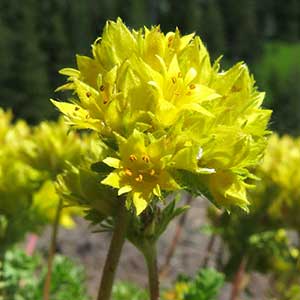Ivesia gordonii var. alpicola
Ivesia gordonii
alpine ivesia, Gordon's ivesia, Howell's ivesia
alpine ivesia, alpine mousetail, Gordon's ivesia
usually greenish, rarely reddish, usually ascending to erect, sometimes decumbent, 0.3–2 dm, not or sparsely hirsute to villous, glandular-puberulent or -pubescent.
prostrate to erect, (0.2–)0.5–4 dm.
2–8(–10) × 0.5–1(–1.5) cm;
leaflets 2–5(–9) mm, hirsute to pilose, rarely minutely glandular at least marginally.
tightly to loosely cylindric, (1–)3–20(–25) cm; sheathing base ± glandular abaxially, otherwise glabrous;
petiole 0.5–8 cm, hairs 0.2–0.5 mm;
leaflets (6–)10–25 per side, (1–)2–13(–18) mm, glabrous or ± hirsute or villous, glandular-puberulent or -pubescent, lobes (2–)4–8(–15), linear or narrowly oblanceolate to obovate, apex rarely setose.
1(–2), not paired.
5–25-flowered, usually simple, 1–3(–4) cm diam., glomerules usually 1, ± capitate.
5–50(–70)-flowered, 1–8(–11) cm diam.;
glomerules 1–several.
1–3(–5) mm.
5–9 mm diam.;
epicalyx bractlets (1.5–)2–3(–4) mm;
hypanthium (2–)2.5–3.5(–4) × 2.5–4 mm;
sepals 2–4(–5) mm, acute;
anthers rarely red-margined.
5–12 mm diam.;
epicalyx bractlets linear to narrowly elliptic, (0.5–)1–3.5(–4) mm;
hypanthium turbinate to campanulate, (1.5–)2–4(–4.5) × 2–4(–5) mm;
sepals (2–)2.5–5(–6) mm, obtuse to ± acute;
petals yellow, narrowly oblanceolate to narrowly spatulate, (1–)1.5–3 mm;
stamens 5, filaments 1.3–2.5 mm, anthers yellow, sometimes red-margined, 0.5–1 mm;
carpels (1–)2–4(–6), styles 2.5–4.5(–6) mm.
grayish brown to mottled brown, ± 2 mm.
Ivesia gordonii var. alpicola
Ivesia gordonii
P. A. Rydberg (1898) used var. alpicola (as Horkelia gordonii var. alpicola) for compact, high-elevation plants throughout the range of Ivesia gordonii. As circumscribed here, var. alpicola is restricted to plants occurring disjunctly in an arc around the northwestern part of the species range. Populations occur in the northern Coast Ranges and central Sierra Nevada of California, sporadically to Mount Adams and the Wenatchee Mountains in Washington, and from there to the mountains of central Idaho and the Bitterroot Range of Montana. The variety is also disjunct on the Owyhee Mountains of southwestern Idaho.
Plants of var. alpicola average shorter than those of var. gordonii, which occurs farther east and south. In var. alpicola, stems with only glandular indumentum are common; such stems are rare in var. gordonii. Unlike those of var. gordonii, the leaflets of var. alpicola are frequently glandular with only marginal hairs.
(Discussion copyrighted by Flora of North America; reprinted with permission.)
Varieties 4 (4 in the flora).
Ivesia gordonii is the most widespread species of the genus, occurring from Washington to Montana, south to central California and Colorado. The species can be distinguished from other members of sect. Ivesia by the relatively deep hypanthium, which is about as deep as wide. Four varieties are provisionally recognized here (B. Ertter and J. L. Reveal 2007), with the likelihood that future work may indicate additional and/or alternate circumscriptions. Populations that are difficult to assign to a variety can be found where the recognizable taxonomic units come together, for example, in northeastern Utah and western Wyoming, involving var. gordonii and var. wasatchensis, and in California and central Idaho where var. alpicola and var. ursinorum tend to merge.
(Discussion copyrighted by Flora of North America; reprinted with permission.)
1. Leaflets 7–13(–18) mm, glabrous or sparsely hirsute or villous marginally; stems (1–)1.5–4 dm; inflorescences usually branched, 2–8(–11) cm diam., glomerules (1–)2–6(–10), ± capitate. | var. wasatchensis |
1. Leaflets (1–)2–7(–9) mm, hairy or ± glabrous except marginally ciliate; stems (0.2–)0.5–2.5 dm; inflorescences simple or branched, 1–3(–5) cm diam., glomerules 1(–3), ± capitate to loosely congested | → 2 |
2. Stems usually prostrate to ascending, rarely nearly erect, usually dark reddish, minutely glandular or glandular-puberulent to -pubescent; leaves to 0.8 cm diam.; anthers usually red-margined. | var. ursinorum |
2. Stems usually ascending to erect, sometimes decumbent, usually greenish, rarely reddish, hirsute to villous, glandular-puberulent to -pubescent; leaves to 1.5 cm diam.; anthers rarely red-margined | → 3 |
3. Stems usually hirsute to villous, sometimes densely so, glandular-pubescent or eglandular; basal leaves (3–)5–10(–15) cm; flowers 7–12 mm diam.; e Idaho and w Montana to Utah, Wyoming, and w Colorado. | var. gordonii |
3. Stems not or sparsely hirsute to villous, glandular-puberulent or -pubescent; basal leaves 2–8(–10) cm; flowers 5–9 mm diam.; s Washington to California and e to w Montana. | var. alpicola |
- Local floras:
CA,
OR
- Local Web sites:
CalFlora,
CalPhotos,
Flora NW,
PNW Herbaria
WildflowerSearch
iNaturalist (observations)
- LBJ Wildflower Center
- SEINet
- Plants of the World Online
- Encyclopedia of Life
- Wikipedia
- Google Image Search
